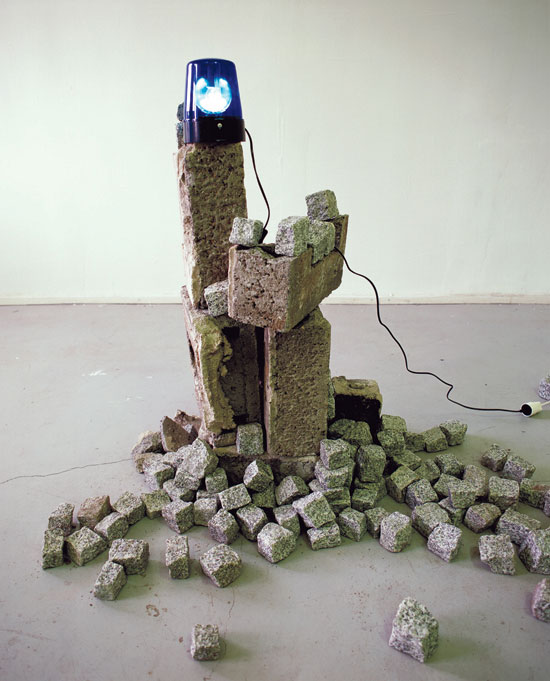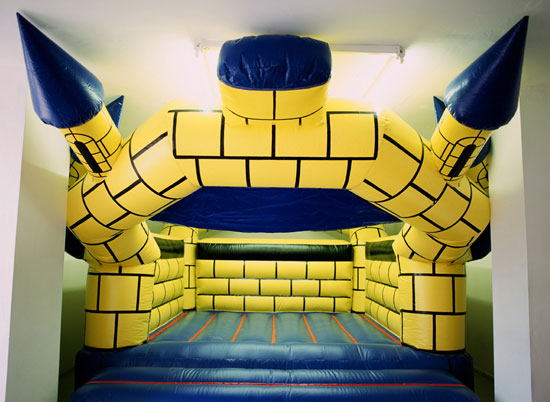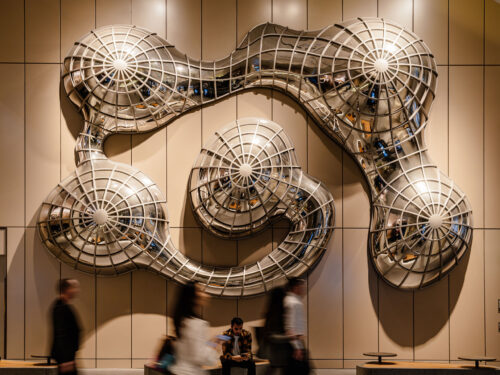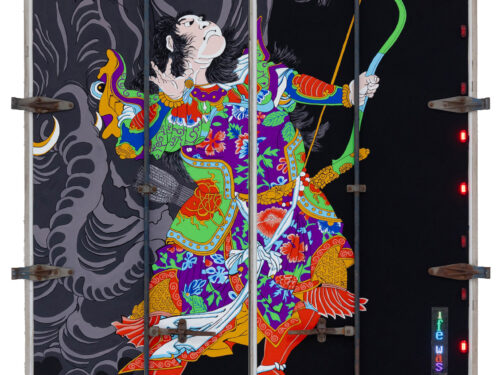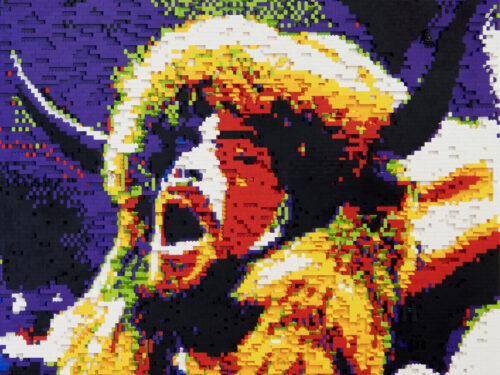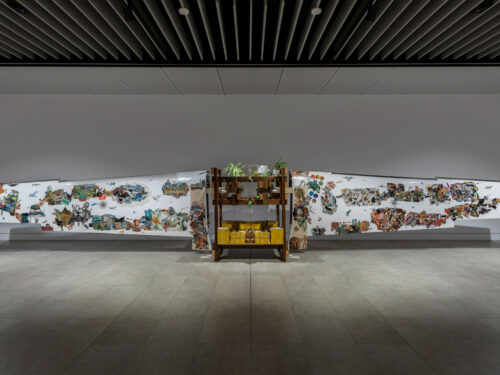
Von Angels zu Riots
[1]
bon-fire dream – a starting point
On the evening of one winter night – the actual date isn’t that important – the yet to be ‘named’ exhibition between solo artist Mikala Dwyer and collaboration artists Claire Healy and Sean Corderio materialized over a little dinner and a little too much wine. Talking about how “things come out in a naïve way”, a conversation about imagination and matter, archeology, traveling the world and visiting each others studios, helped to break the ice between two unlikely sculptural practices. Fuelling the chit-chat, Mikala Dwyer talked about remaking the solidity of architecture through a process of un-building and un-development, while Claire Healy and Sean Cordeiro spoke about Berlin’s urban monuments: the WB5, 70’s – housing ‘relics’ from Berlin, left over from the former German Democratic Republic (GDR). Unnoticed at the time, this conversation was symbolic of a kind of ‘fantasy building’ between two sculptural practices, that when placed next to each other, did not immediately reveal the supporting similarities, normally expected for potential collaboration. Strikingly, the conversation was an important stand in. It filled a curatorial hole, purposely dug out.
Yet every hole in the earth isn’t necessarily frightening. Indeed, this particular hole was intended to more as a well. This hole in the earth had a mirror at its base, which when looked at from a particular point of view, offered a reflection of the lookers gaze. Metaphorically, this dug out well was about reflecting notions of artistic source material (be they existent or otherwise), on the one hand, and the desire to fish out artistic collaboration, on the other.
[2]
tonight’s talk for tomorrow’s exhibition
The exhibition, “vonANGELSzuRIOTS”, is a collaborative art project between artists Mikala Dwyer, Claire Healy and Sean Corderio. Presented formally in three distinct setting, “vonANGELSzuRIOTS” sees itself, firstly, as a public artists’ talk; secondly, as an art exhibition; and thirdly, as the written responses formalized in this printed exhibition broadsheet. Dealing primarily with the work of artistic collaboration, “vonANGELSzuRIOTS”, uses the space (and in-between spaces) offered by these three settings to reveal insights into the artistic processes of collaboration. Tracing the transitions from casual conversations, to formal talks or following the ambitions of would-be works to their actual realization, “vonANGELSzuRIOTS” is an exhibition that grapples with these different modes, in order to discover the promises (and let down’s) of working together, artistically.
On the 21st of March, 2006, Mikala Dwyer, Claire Healy and Sean Cordeiro accepted an invitation by Sparwasser HQ to present their respective works, to an organized public, under the night’s title, Discourses of Winters, Dialogues of Springs. In part responding to the retrospective based presentation norms of most artists’ talks, that night’s talk sought to treat the dialogic space offered as the artistic engine that would kick-start “vonANGELSzuRIOTS’s” artistic collaboration. Seen from this curatorial perspective, the one added difference to the artist talk structure was a consideration of artistic source material, where fleeting interests, visual curiosities, existing inspirations, on-going concerns and interests, unfinished or works in process were presented, hoping to find some understanding of one another’s artistic positions, building towards an exhibition as a result.
[3]
unintended curatorial strategies
From source material to collaboration; amongst the to-and-fro of artists and curator; positioned in between the work of art and the spectator; from dialogues to art, are the many multitudes that describe
“vonANGELSzuRIOTS”. Yet rather than starting from the exhibitions beginning, perhaps it is better (if not more desirable) to unwind the processes of art-come-exhibition making and look back on exhibition, enframing this ‘thing’ – we call ‘art’.
Stealing from the words of the German philosopher Hans-Georg Gadamer, something about play.
[4]
Separate yet together
Text about the actual works, un-packing them individually….
[5]
conversation continues
[J.M.]: Working on artistic collaboration is something not normally taken up in your practice, and yet you agreed to participate in this project, with a curator and two collaborating artists you know very little about. I remember you once observing that Europe, and Berlin in particular, to be harder on far-flung Australian artists – why did you take on this project? Was it simply a comforting distraction or was there something discomforting as well?
[M.D]: Joel asked if I wanted to do this project and I thought I didn’t. I’d done enough collaborations to think that they were a waste of time and I didn’t think I had anything in common or to offer the other artists. Also the idea of revealing source material in public and somehow thru discussion “this would magically transform into a collaboration didn’t convince me either ,but…I always say yes to everything and then try and wriggle out of it later. when I’ve analysed all options in that opportunistic way. but it wasn’t so easy ….as I got thinking about the idea of source material and it was for some reason making me angry. Source……..material. I realise that I didn’t have any .Maybe my source became material but to start with its not matter of a sort that I could easily describe. More like impulses that I desperately try to fall into and at the same time understand. Mapping my own consciousness as an available guinea pig. Also trying to map with co-ordinates of my own making. Zero objectivity., easy to get lost with this kind of anti-map. So stupid to consider collaborating.
I suppose I was more interested in how it might fail.
[J.M.]: Coming together collaboratively is never guaranteed. For this project how would you characterize this notion commonality; what does it offer up; and what does it take away? I wonder where your own self goes when positioned to confront, artistically, the selves of others?
[M.D]: We had a few meetings where we would sometimes drink too much and talk ourselves up into funny plans of performing renovations, hospitals, Drs and nurses ,sausage sellers, fires, riots etc etc.
And I thought maybe it was the ‘not so much in common’ that gave us a way of working together, making a reverse or contradictory space that I thought could be an interesting place of departure..
[J.M.]: A significant aspect of this project was the dialogic spaces thrown up at the Sparwasser HQ artist talk. For myself as a curator, I wanted to utilize this space as an opportunity to gain some kind of creative empathy, so that when collaborating later, the artists would have something to fill in that great gap of lack, inherent in not knowing each others work, personality, or practice. Research is often used to describe this opportunity to gain what I call creative empathy – did you feel like a researcher or was there something else at play in this public situation?
[M.D]: In their talk Sean and Claire mentioned something about dark matter which I thought was a nice description of the density of their stacks, not just the material but a compression of memory and space. somehow this idea must of stuck, the work I ended up contributing is sort of dense and heavy. whereas the jumping castle is light and full of air, but also dominant .
At first I didn’t know how to place myself with these 2 people who had been collaborating together for years. I found them overwhelming in the speed with which there ideas could take shape and appear in the world, somehow though this reminded me of all my Australian friends and there reckless will to just do stuff. A blind faith in making stuff happen necessary in a country where if you don’t there is a vast White nothing (terra nulias) against a Blak something of 60,0000 years.. So a tendency to fill space in a reckless panic is maybe a survival instinct foreign now to Europeans here as its been stuffed to the gills for a long time now.
[J.M.]: During the opening, I was often asked which work belonged to whom. In answering, I suggested that conceptually the entire exhibition was one work, brought about by a collaborative force, whatever that ‘force’ may be. As a curator it is perhaps easier for me to make such totalizing statements. As an artist, what would your answer be – how would describe the relation between the works?
[M.D]: The collaboration seemed to be consumed by a desire to overfill a room with a huge jumping castle. I have to admit to being self obsessed and more interested in what I was pottering with in my studio than trying to force connections with sausage sellers and cobbles and videos of the deconstruction of their studio work. I felt like there wasn’t a space for me so I decided to stake one out, a psychic fortress in the form of a tent ,The antithesis of an idea of a castle. A perverse gesture to ward off and sabotage any possibility of collaboration ,architectural voodoo. What’s funny though is how that fails and no matter what I do otherness will always breach it and a collaboration seems to occur anyhow.
A small pile of rocks grow into a ruin and some sense of play contaminates my self/ishness.
I feel the echoes of all castles across time, sand, stone , air and fucked up fairytales and I walk down the street with a Jimmy Hendrix hohrewurm …………….’melt into the sea eventually’.
[J.M]: In your collaborative practice, the socio-political landscape figures quite significantly in your work. In Berlin, the loadedness of this landscape is clearly observable, bearing the traces of history and the fresh marks of today. For this project, how did Berlin as a ‘place’ impact on your contribution? Is the concept of source material appropriate here? And how would you measure your ability to connect, personally, while connecting others, artistically?
[C.H.] Of course the concept of source material is appropriate. Without it we wouldn’t have a place to start. Which would be awful. But we cannot take Berlin as a blank canvas. It has to be in relation to our relationship to the space- architecturally, historically and culturally. I think that a lot about this wok is our inability to connect with Berlin in a personal or artistic fashion. Does that sound bad? Perhaps that’s how we ended up with a soundtrack to our show that was titled ‘trench warfare’. What input can we offer, as people from a minor European colony, to Berlin? We don’t want to talk about koalas, neither do we want to make work out of felt and fat.
[J.M]: For a solo artist, the practice of collaboration is a less familiar one. As the other part of a collaborating pair, how is this different? Is there ever a situation where the reverse happens, where you find yourself working as a solo artist and did this happen in this project? Or are the distinctions between solo and collaboration unstable to begin with?
[S.C.]: Of course communication is always a funny thing within collaborative practice. The ability to say ‘nah, that idea sucks’ or ‘why do you wanna do that for?’ without upsetting your co-collaborator(s) is very important. Collaborating with other people is like pulling down a house. You have to be in constant communication with one another while still being mindful of what you doing: otherwise people get hurt tor the job gets outta hand and too messy and you want to quit. Being in a collaboration is pretty much like being in a band after a little while, things can get pretty slick and the machine runs smoothly. But sometimes you have to shake this up a little too. I think that the idea of revere is pretty important in making art too. This is something that can be lost when working in collaborations, all the constant dialogue over what’s going on can make you miss out on zoning out, which is the fun part of art-making. That’s why it’s also nice for individuals with the collaboration to maybe focus on particular aspects of making a work. Then, after this is done you can come back together and make assessments. I think that this project was tough for us because we had a lot of things on our mind at the time. But this just became another parameter that we had to work within which is actually ok when you work in a team. Because we didn’t really have the space to make something physically over some time, we really had to work conceptually together, in order for the work to really be true to what we set out to do. I think we achieved that. As for distinctions between solo and collaborative practices, who knows?
[J.M]: In many ways, Mikala Dwyer’s work is very different from your own collaborative practice. Yet as sculptures’ there is still something that ties aspects of your works together. Here, in this sense, I’m not just referring to the formal aspect of object making, but more about an esotericness that is brought in relation to these objects or situations. Is this a fair observation or are there limitations to this suggestion – how do you see your work in relation to Mikala Dwyer’s work?
[C.H.]: I remember being in a group exhibition in Melbourne with Makala, we did not know each other and still although in a show together, never even met. The show was in an historic garden surrounding Melbournes’ largest Mansion, her piece was made of mirror and were sculptural letters spelling IOU. There were many levels in which to read her work. I was very curious of the piece and felt very touched by it, particularly the relationship the piece had with the birds, which consistently pecked at the mirrored surface. Her ability to work with site is what intrigues me. Instead of working in a literal sense, Mikala has an ability to questions the presence of stuff that perhaps cannot be seen by the naked eye. For me Mikala delivers an emotional response, or an esoteric critique of a site, by adding physical stuff and inviting the presence of an individual athis essoteric environment is created. Where as our work seems to be a direct enquiry of the site, whether historic, social or an architectural enquiry, we tend to investigate the formal and spatial aspects, (as does Mikala) but it seems Mikala is working on a 5th dimension as well.
[J.M]: Perhaps a too over-riding feature of this project is the notion of process that draws out an exhibition from a set of, predominately curatorial, parameters. When thinking about the production of your work, the interests of a specific curator must surely not lean so heavily. How then has this curatorial situation faired, both from the perspective of an artists ‘making’ new work and in the interests on the exhibition as a whole? Curator’s can do either too little or not enough, it’s a hard position to balance, wouldn’t you agree?
[S.C.]: Different strokes for different folks I says. Some curators check out your work and are happy to let you do your thing because they have faith in you. Others really get in there and question things and make suggestions until you wonder why they didn’t make the piece in the first place. Other curators never answer emails, never phone but make sure they have ‘curated by..’ printed on the flyer. This project was funny. Mikala’s had more shows than you’ve had hot dinners and we’ve been around for long enough to know when things are working and when thing aren’t, whereas this was your first international gig. It was kinda frustrating at the beginning because we had a tough time trying to hammer out what exactly we were going to do for this show for some time. While all the while we had a whole studio filled with completed works that we hadn’t shown in Berlin! That kinda sucked. But we thought that the concept behind the talk and the show was curious enough to persevere. That’s the tough thing about being a curator, it’s one thing to have an interesting concept to work from but it’s another thing to find people who can fit into this idea or have the time to set there tools down and really apply themselves to the new concepts at hand. It must be different if you are mixing existing works. But I think that a lot of goodwill was shared in this project. We were pretty stressed out at the time with other commitments and if it hadn’t been for Mikala’s bonhomie and your hard work we would have probably said ‘fuck it’.
[6]
credit
Mikala Dwyer [AUS] is an artist with current projects in Berlin , Warsaw , New Zealand , New York and Sydney . Primarily working with sculpture, her work currently deals with experimental architecture and superstition. In 2003, her work was selected for a group show at the Hamburger Bahnhof, Berlin, entitled Face up: contemporary art from Australia, while her other group exhibitions have taken place at the Bonheurs des Antipodes, Musee de Picardie, Amiens, France (2000) and at the 4th International Istanbul Biennale (1995). In 2000, she was invited for solo shows at the Museum of Contemporary Art , Sydney and at the Chapter Arts Centre, Cardiff . This year, Mikala Dwyer had been invited to take part in a touring group exhibition Hide Tide in Poland , which will travel to the Zacheta National Gallery in Warsaw and to the Contemporary Art Centre in Vilnius .
Claire Healy [AUS] & Sean Cordeiro [AUS] are installation artists currently working on projects for Berlin , Copenhagen and Sydney . Dealing with issues of architecture, urban development, social gentrification and space invasion, the couple continues to investigate these concerns, driven by their own state of international homelessness. Current Australian residents at the Künsterhaus Bethanien, Berlin, the pair have expanded their collaborative art practice from large scale site specificity to studio based object works. Alongside other Australian Arts Council grants, the pair were awarded in 2006 the Anne and Gordon Samstag Scholarship for Visual Arts. Claire Healy & Sean Cordeiro are now currently working towards a collaborative art project with the Swiss-based artists: Simone Fuchs and Martin Blume.
Gadamer, Hans-Georg, Truth and Method, Translation by Joel Weinsheimer and Donald G. Marshall, Continuum, UK, pp. 102-157.
